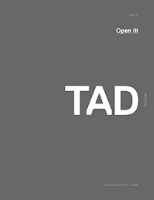
Technology-Architecture + Design
Scope & Guideline
Redefining Architectural Practices with Technological Insights
Introduction
Aims and Scopes
- Sustainable Architectural Practices:
Research in this area emphasizes the development of sustainable design methods, materials, and technologies that minimize environmental impact and enhance the resilience of buildings and urban areas. - Integration of Artificial Intelligence and Machine Learning:
The journal features studies on how AI and machine learning techniques can optimize design processes, enhance building performance, and facilitate the management of architectural projects. - Climate Adaptation and Resiliency:
Papers focus on strategies for adapting architectural practices to address climate change, including innovative designs that respond to environmental challenges such as flooding and heat. - Digital Fabrication and Construction Automation:
The journal explores the implications of digital fabrication techniques and automation in the construction industry, discussing how these technologies can improve efficiency and sustainability. - Interdisciplinary Approaches to Design:
Emphasizing collaboration across disciplines, the journal publishes work that bridges architecture with engineering, urban planning, and environmental science to create holistic design solutions.
Trending and Emerging
- Climate Change Mitigation Strategies:
Recent publications emphasize the urgent need for architectural solutions that address climate change, showcasing innovative designs and technologies aimed at reducing carbon footprints and enhancing energy efficiency. - Circular Economy in Architecture:
A notable trend is the growing focus on circular economy principles, where research explores sustainable materials, recycling, and design strategies that promote resource efficiency and waste reduction. - Smart Cities and Urban Resilience:
The exploration of smart city concepts and technologies that enhance urban resilience is gaining traction, reflecting a shift towards integrating digital solutions in urban planning and architectural design. - Health and Well-being in Architectural Design:
Emerging research highlights the importance of designing spaces that promote health and well-being, incorporating factors such as natural light, air quality, and community engagement into architectural practices. - Interdisciplinary Collaboration for Innovation:
The trend towards interdisciplinary collaboration is evident, with increasing publications that bring together architects, engineers, and technologists to develop integrated solutions for complex design challenges.
Declining or Waning
- Historical Architectural Analysis:
Papers focusing on the historical aspects of architecture have become less frequent, indicating a shift towards contemporary and future-oriented design practices rather than retrospective studies. - Traditional Construction Methods:
Research centered on conventional construction techniques appears to be decreasing, as the focus moves towards innovative and technologically advanced methods that align with sustainability goals. - Purely Aesthetic Design Considerations:
There is a noted decline in papers that prioritize aesthetic considerations alone, with a growing emphasis on functional, sustainable, and technologically driven design solutions.
Similar Journals
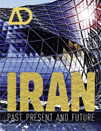
ARCHITECTURAL DESIGN
Elevating Architectural ConversationsARCHITECTURAL DESIGN, a leading journal published by Wiley Periodicals, Inc., serves as a vital platform for discourse in the fields of architecture and visual arts. With an ISSN of 0003-8504 and an E-ISSN of 1554-2769, this esteemed publication offers comprehensive insights into contemporary design practices and emerging architectural theories. Established in the United States and continuously evolving from 2002 to 2024, the journal has secured a prominent position with a Q3 status in Architecture and an impressive Q1 ranking in Visual Arts and Performing Arts as of 2023. Its Scopus rankings further affirm its relevance, with a percentile ranking of 82nd in the Visual Arts category. Although it does not currently offer Open Access options, the journal remains dedicated to disseminating high-caliber research and innovative design strategies that engage a diverse readership of researchers, professionals, and students alike. The contributions published within its pages are instrumental in shaping the discourse around architecture, making ARCHITECTURAL DESIGN an indispensable resource for anyone passionate about the built environment.
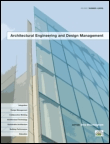
Architectural Engineering and Design Management
Exploring the intersection of engineering and design management.Architectural Engineering and Design Management, published by Taylor & Francis Ltd, is a leading journal dedicated to the interdisciplinary fields of architectural engineering and design management. Since its inception in 2005, the journal has established itself as an essential resource for researchers and practitioners, showcasing the latest developments and innovative practices within the architecture and construction industries. With a commendable impact factor reflected in its Q1 ranking in Architecture and high standings across building and construction, it addresses critical themes such as sustainable design, integrated construction processes, and management strategies that drive efficiency and creativity in evolving architectural contexts. Researchers will find the journal's commitment to disseminating high-quality research—evidenced by its impressive Scopus rankings, including a #13 ranking in Architecture—particularly valuable as it fosters a deeper understanding and advancement in the profession. The journal is accessible in print and online, ensuring that academic and professional communities stay at the forefront of architectural engineering innovation.

En Blanco-Revista de Arquitectura
Illuminating Contemporary Practices in Design and ArchitectureEn Blanco - Revista de Arquitectura is a peer-reviewed journal published by UNIV POLITECNICA VALENCIA, EDITORIAL UPV, specializing in the field of architecture and design. This esteemed publication aims to bridge theoretical advances and practical applications within the architecture domain, showcasing innovative research, critical essays, and multidisciplinary approaches. With an emphasis on fostering dialogue among researchers, professionals, and students, En Blanco serves as an essential platform for disseminating cutting-edge ideas and discussions that define contemporary architectural practices. Although currently offering non-open access content, the journal is dedicated to promoting accessibility through insights that resonate beyond its pages. With an ISSN of 1888-5616 and E-ISSN of 2445-1215, En Blanco is a pivotal resource for any architecture enthusiast looking to enrich their understanding and contribute to the evolving discourse in architectural studies.

Prostor
Advancing Architectural Dialogue for a Sustainable FutureProstor is an esteemed scholarly journal published by the University of Zagreb, Faculty of Architecture, dedicated to advancing knowledge in the fields of architecture, urban planning, and spatial studies. Since transitioning to an Open Access model in 2006, Prostor has made significant strides in providing unrestricted access to its contents, fostering a vibrant community of researchers, practitioners, and students interested in contemporary issues surrounding the built environment and social space. The journal's commitment to quality is reflected in its impressive rank within Scopus, particularly in the Arts and Humanities category (64th percentile) and within Engineering (Architecture) at the 49th percentile. Covering a broad array of interdisciplinary topics, Prostor serves as a vital platform for disseminating innovative research and fostering dialogue among professionals while engaging with practical and theoretical explorations of spatial design. With coverage spanning over two decades, Prostor remains a crucial resource for anyone seeking to navigate the complexities of architecture and urban studies.
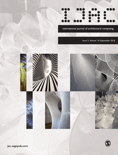
International Journal of Architectural Computing
Innovating Design Solutions for Tomorrow's Challenges.International Journal of Architectural Computing, published by SAGE Publications Ltd, serves as a vital platform for researchers, professionals, and students engaged in the intricate intersections of architecture, computing, and design. With an ISSN of 1478-0771 and an E-ISSN of 2048-3988, this esteemed journal has maintained a commendable standing in the academic community, reflected in its categorization within the top Quartiles (Q2) for both Building and Construction and Computer Graphics and Computer-Aided Design in 2023. The journal operates out of the United Kingdom and showcases innovative research that revolutionizes architectural practices through computational advancements, contributing meaningfully to global discourse. While the journal does not currently follow an Open Access model, it continues to uphold high academic standards, as indicated by its Scopus rankings, including a notable rank of #93 out of 223 in Engineering - Building and Construction. The journal encompasses a wide range of topics, inviting submissions that address contemporary challenges and methodologies in architectural computing, making it essential reading for those passionate about bridging the gap between design and technology.

Advances in Civil and Architectural Engineering
Advancing Knowledge for a Sustainable Built EnvironmentAdvances in Civil and Architectural Engineering is a cutting-edge scholarly journal dedicated to the dissemination of pioneering research in the realm of civil engineering and architecture. Published by the esteemed Josip Juraj Strossmayer University of Osijek, Faculty of Civil Engineering and Architecture, this journal operates under an Open Access model since 2022, allowing for unrestricted access to its rich repository of articles. The journal aims to bridge the gap between academia and industry by providing a platform for innovative studies, technical advancements, and best practices that contribute to the evolution of sustainable construction and architectural design. With its focus on interdisciplinary approaches and contemporary challenges in the field, Advances in Civil and Architectural Engineering serves as an invaluable resource for researchers, professionals, and students seeking to enhance their understanding and impact in this vital area of engineering. The journal's ISSN is 2975-3848, and it is committed to fostering the advancement of knowledge and collaboration within the global engineering community.

Landscape Architecture and Art
Fostering Sustainable Design in the ArtsLandscape Architecture and Art is a distinguished journal published by the Latvia University of Life Sciences and Technologies, specializing in the intersection of landscape architecture, environmental design, and the visual arts. Established in 2016, this journal has rapidly garnered recognition in various academic categories, achieving Q3 ranking in Agricultural and Biological Sciences (miscellaneous), Q4 in Geography, Planning and Development, and notably Q1 in Visual Arts and Performing Arts as of 2023. With its ISSN 2255-8632 and E-ISSN 2255-8640, the journal provides an essential platform for researchers, professionals, and students to explore innovative approaches and sustainable practices in landscape design and conservation. Although currently not open access, the journal's commitment to high-quality research is evident through its impressive Scopus rankings, particularly in the Arts and Humanities with a commendable 88th percentile for Visual Arts and Performing Arts. Located in Jelgava, Latvia, this journal serves as a vital resource for advancing knowledge and fostering collaboration in the fields of landscape architecture and environmental stewardship.

Boletin Academico-Revista de Investigacion y Arquitectura Contemporanea
Illuminating Contemporary Perspectives in Architecture and Culture.Boletin Academico-Revista de Investigacion y Arquitectura Contemporanea is a distinguished journal published by SIELAE & UNIV CORUNA, Fac Filologia, focusing on the interconnectivity of contemporary architecture, cultural studies, and visual arts. With an E-ISSN of 2173-6723, this open-access publication serves as an essential resource for researchers, academics, and professionals eager to explore innovative perspectives and methodologies in these dynamic fields. Spanning a commendable period from 2016 to 2023, the journal demonstrates a strong academic footprint, ranked in the Q2 category for both Architecture and Cultural Studies, and holds a prestigious Q1 ranking in Visual Arts and Performing Arts. With Scopus rankings reflecting its growing influence—particularly in Visual Arts and Architecture—Boletin Academico delivers a platform that is not only academically rigorous but also culturally relevant, encouraging discourse that shapes the future of contemporary architectural and artistic practices. The journal’s commitment to open access further enhances its appeal, ensuring that groundbreaking research is readily available to an extensive audience.
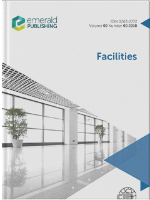
Facilities
Championing high-quality research in architecture and ergonomics.Facilities is an esteemed international journal, published by Emerald Group Publishing Ltd, dedicated to advancing the scholarly discourse in the multifaceted areas of architecture, building construction, and human factors and ergonomics. Since its inception in 1983, the journal has celebrated over four decades of research contributions, maintaining a robust E-ISSN of 1758-7131 while its print identifier is ISSN 0263-2772. With its distinguished status, it ranks in the Q1 quartile in Architecture and is positioned in the Q2 quartile for both Building and Construction and Human Factors and Ergonomics in 2023. The journal’s Scopus rankings highlight its relevance, achieving a remarkable 88th percentile in Architecture and 68th percentile in Building and Construction. Although not an Open Access publication, Facilities provides vital insights and research findings that cater to academics, practitioners, and students alike, fostering innovation and informed practices across these dynamic fields. Its commitment to high-quality scholarship makes it an indispensable resource for anyone engaged in improving the interaction between people and the built environment.
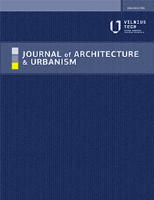
Journal of Architecture and Urbanism
Pioneering Research for Evolving Urban ChallengesThe Journal of Architecture and Urbanism, published by VILNIUS GEDIMINAS TECH UNIV, stands as a pivotal resource for scholars and practitioners in the fields of architecture and urban studies. Since its inception in 2012, the journal has committed to advancing research and discourse on the design, planning, and functionality of urban environments, reflecting a dedicated focus on contemporary challenges in architecture and urbanism. With an impressive open access model implemented since 2018, it ensures that innovative research is accessible to a global audience, fostering collaboration and knowledge exchange. The journal boasts a commendable reputation, categorized in the Q2 quartile for Architecture and Q3 in both Geography, Planning and Development and Urban Studies as of 2023, while maintaining respectable Scopus rankings. Addressing key themes from sustainable design to socio-economic impacts on urban spaces, the journal aims to inspire new models and solutions that meet the evolving needs of growing urban populations. This is a must-read for anyone engaged in the intersection of architecture and urban development.